Need a little help getting through the end of the school year? These tried and true French and Spanish end of year activities will keep your students engaged and learning.
You know you’re ready for the school year to be over when:
A. You’re secretly daydreaming about your summer vacation plans.
B. Your daily countdown to summer started way before your students started counting.
C. You stare longingly out the window while your students are taking quizzes.
D. All of the above!
No worries, I’ve got you covered with 16 French and Spanish end of year activities and games that require very little effort on your behalf.
And the best part is . . . that the students will still be learning!
Check out this list – I’m sure you can find something so that you’ll have time to daydream about your summer plans. 🙂

French, Spanish End of Year Activities
1. Instead of you creating French or Spanish end of year review packets for the final exam, have your students make them.
Here’s how this review activity works:
* Divide students into groups of 3-4 and assign each group a unit from your textbook or a few topics to cover. These students must then type up a few review pages which include:
– a concise list of vocabulary with definitions in English
– brief notes reviewing the grammar concepts
– notes about the culture from that unit
* The group prepares a review game of their choice that covers all of the material from the unit. They will briefly reteach the grammar to the class and then lead the class in playing the review game.
What You’ll Need to Do:
Create a grading rubric, correct the rough drafts of the study guides, correct the final copies with their corrections of the study guides, make copies for the class, and grade their presentations. Your rubric might include: initial grammar, final grammar, grammar instruction (all in the target language, accuracy, class engagement), and review game (speaking all in the target language, creativity, preparation, grammar).
Why This Works:
At this point in the year, your students really don’t want to listen to you, but they will listen to their peers. Also, you know what they say, “You really learn a topic well when you teach it.” At the very least, they’ll know one unit really well for the final exam even if they don’t study at all.
2. Add Some New French or Spanish Review Games to Your Repertoire
By this time of the year, the kids are bored with the same games. Throw a few new games into the mix to re-energize your class. Most times, the students can run the games themselves – just pick a student to be the teacher and then rotate through other students during the game. The kids love getting to be the teacher and this works well because, at this point in the year, they’re more likely to listen to a peer than to you. Your students will be learning and reviewing while you are grading papers or preparing final exams.
And guess what? I’d love to share 50 of my favorite World Language games and activities with you. Trust me – there are some really fun, engaging games in here that will really get your students up and moving. Get them and other engaging lesson plans in my Free Resource Library.
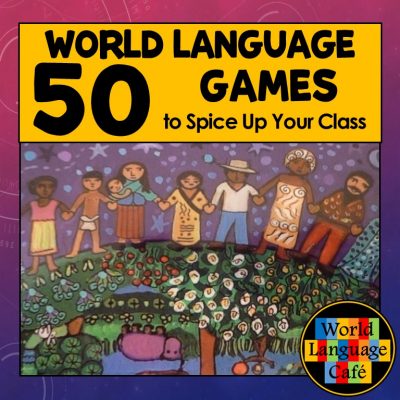
50 Games for the World Language Classroom
3. Assign a Fairy Tale Writing Project
I do this every year with my juniors and seniors – it’s a great way to put everything that they’ve learned throughout the year to good use. You’ll be amazed at how much they learn.
Here’s How It Works:
- Read a fairy tale or two in the target language to your students (or have them take turns reading one aloud). Discuss the elements of fairy tales (description of the characters, fantasy, some sort of adventure/challenge that the characters face, a moral, etc.). This will help prime them and spark their imagination for the project.
- Divide the class into small groups of 2-3 people. Let them pick their partners for this project because they’ll need to coordinate times to work together outside of school.
- Students write the fairy tales, then do peer edits, you check it over and highlight parts that need fixing, then they write a final draft and you check it over once more and fix any remaining errors.
- They create the actual fairy tale book with illustrations. You may be thinking that some students aren’t very good at art, but they really don’t need to be. There are lots of ways to do illustrations without a lot of drawing. I encourage my students to use everyday household items to make their illustrations pop.
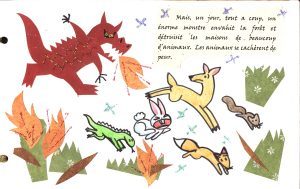
French Fairy Tale Writing Project
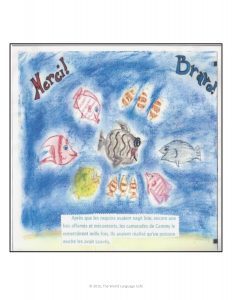
French Fairy Tale Writing Project
Want detailed student instructions, a step-by-step teacher guide, plus peer edit sheets, grading rubrics, and 100 transition words to help your students write more fluidly? Check out the French and Spanish versions.
4. Turn Your Classroom into a World Language Cafe
Spend one class period a week having a language cafe. Each week, a few students prepare a traditional dish or treat from a country that speaks the target language. They are responsible for bringing enough food, utensils, napkins, etc. for the whole class.
After everyone has their food, the students explain in the target language which ingredients they used, how they made it, and where it’s from.
Prepare themes/questions ahead of time and make a copy for each group. Base the themes loosely around whatever grammar points, vocabulary you’re working on at the time.
For example, if you’re studying the future tense, one of your questions might be, “Imagine your life in 10 years. Where will you live, what will you be doing. If you’re studying the conditional tense, ” What would you do if you were the principal for a day?”.
They will use these as conversation starters for their discussion. Then divide the classroom into 3-4 groups to discuss different questions/themes.
One person in each group will be the recorder who makes a mark next to each person’s name that speaks, 1 point for answering a question, 2 points for asking follow-up questions. This gives the students incentive to speak in the target language and to keep the conversation going.
Another person will be the moderator, in charge of keeping the discussion on track and asking questions of anyone who isn’t speaking a lot.
The whole point is to get the students speaking in the target language and talking in real-life situations. This is always a favorite activity in my classes. We actually do it all year long because it’s such a valuable activity. Love it when they can be learning and having fun at the same time!
5. Boom Cards for Review
If you haven’t checked out Boom Cards yet, they are such a simple, effective learning tool. Digital, self-correcting, native speaker sound files – just send the link and your job is done. Many people think you need a paid Boom account, but your students can use them with your free teacher account.
If you teach French or Spanish 1, I just created 3 decks to review all of Spanish 1 vocabulary. Check them out! They are perfect for sub plans, in-class review, or homework. Here is the French version.
Grab a free clothing deck in the Free Resource Library or select a specific review theme:
French:
ER Verbs RE Verbs IR Verbs Expressions with Avoir Reflexives Savoir + Connaître Clothing Colors Foods Prepositions Family School Weather Time Alphabet Body Sports Numbers French 1 Vocab Review
Spanish:
AR Verbs ER, IR Verbs Verbs Like Gustar Numbers Expressions with Tener Reflexives
Saber + Conocer Countries Clothing Colors Family Foods Prepositions School Weather Alphabet Body Subjunctive Sp. 1 Vocab Review Listening Exam
6. Try Interactive Notebook Trifold Flashcards
These are called interactive notebook flashcards (either regular style or Spanish trifolds or French trifolds), but they can be used with regular notebooks or digitally, too. If you’re looking to review a certain vocabulary theme or verb tense with your students, these flashcards can be used for games, individual student practice, as sub plans, or for homework assignments.
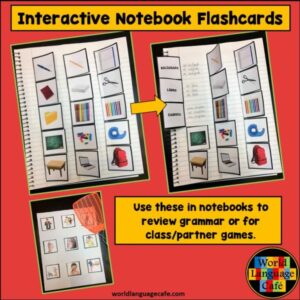
French, Spanish Interactive Notebook Trifold Flashcards
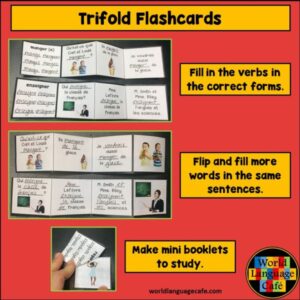
French, Spanish Interactive Notebook Trifold Flashcards
Here’s a video explaining what trifold flashcards are and how to use them or you can check out my blog posts about them: why traditional flashcards just don’t work and revolutionize the way that you teach verbs, vocab, and grammar.
Grab some free trifolds in the Free Resource Library!
7. Conduct an End of Year Survey
It’s always good to get some feedback on your teaching throughout the year from the student perspective and the students love knowing that you care about what they think. Make the survey anonymous so that students feel comfortable expressing their true feelings. Ask questions such as:
* What was your favorite game that we played this year and why?
* Which topic was the hardest to learn and why? Do you have any suggestions on making it easier for future students?
* How could your teacher have done better to help you learn more this year?
* Teacher strengths/weaknesses?
Compile the answers from that last question and keep them on a sheet called: Here’s What My Students Say about Me. This is an awesome tool to whip out during any future teaching interviews that you may have or to keep in your teaching portfolio.
8. Play Their Favorite Game/Activity Again
Students love to do things that they know. Use the results of your survey (or do a quick class poll to find out which game was their favorite) and try to incorporate it into your French or Spanish end of year activities. This time, let them come up with the game questions or be the teacher for the activity.
9. Have Students Do Spanish Speaking Countries Research Projects
In pairs, students research one of the Spanish-speaking countries and prepare a presentation. Depending on the age and level of your students, you can incorporate different activities such as:
Level 1: Make a poster showing the flag, a map that shows where the country is in the world, a few photos, and some facts about the people or culture.
- This food component can be used for all the levels. Students research a specific recipe from the country, prepare it, and share with the class. Perhaps you can even use the home ec kitchen so students can cook together. Here’s a great post from Sarah Barrientos Svatos about cooking at school with students.
Level 2: Pretend you just visited the country. Describe your journey using the preterite. Students incorporate information about landmarks, historical, cultural and tourist places, events, celebrations, and of course, the food they ate while they visited.
Level 3: Same as above, but using the preterite and imperfect.
This amazing idea came from Lucy Garcia-Fischer. She’s part of our World Language Cafe FB group. Come join us in our online World Language Teacher’s lounge where we share ideas, humor, and teaching tips with teachers from all over the world.
10. Create an End of Year Memory Page in Class
Kind of like a yearbook page except in the target language. Here is a sample of the one I use in French or Spanish.
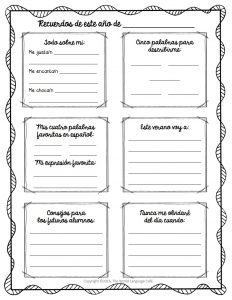
Spanish End of Year Memory Page
11. Write Letters Giving Advice to Next Year’s Class
Students really enjoy thinking back on what they’ve learned this year and sharing it with future students. This activity makes them feel like they are older and wiser and helps solidify study skills and good learning habits that they can use in next year’s class. It’s fun to save these letters and show them to your new students next year.
12. Students Create Their Own Review Games
Divide them into small groups and give each group a few topics from the year to cover in their games. Have them prepare their own games for class. Spend a day or two playing the games.
13. Take Your Class Outside
At least here in the Northeast U.S., everyone is itching to be out in the nice weather. Bring your class outside. It’s usually just as easy to do whatever activities you had planned outside and the kids will adore you for it. Or go on a walk and learn new vocabulary for what you see outside.
14. Do a Photo Scavenger Hunt
Have students find photos or draw pictures of things they find around the school or outside. For example, students can try to find: something metal, something made of wood, something that’s alive. Make the list in the target language and students must find the items and take a picture of them. They write a few sentences explaining or describing what they found and then share with the class.
Tech Variation: Students download the free PicCollage app and they take a picture of the page that has the hunt list and insert that as their background image. Then they can layer the images on top to create their collage. Afterward, they can put the image in a PPT file and record themselves saying a few sentences about each item. Another option is to have each group write a few sentences about each item and overlay the text on the photos. Work through the editing process with them and then post these around the class.
15. Let Your Students Teach a Topic
Let’s be honest. At this point in the year, students have no interest in listening to us anymore. So I say, “Let them teach”. After all, they do say that the best way to learn is by teaching. Now, I’m not saying that you should put your students in charge of teaching the subjunctive tense, but you can definitely put them in charge of teaching vocabulary or planning a mini-lesson or review game.
16. Do a Famous Hispanics, Famous Francophones Game and/or Research Project
Have students write 20 clues about a famous Hispanic or Francophone person. Then they read their clues aloud one at a time and students try to guess who the person is. You’d be amazed how well this activity works to review sentence writing skills.
For more advanced students, have them write a resume (curriculum vitae) for a famous person and present information to the class, along with an audio-visual component.
Want 20 clues for 25 famous people that you can use right away with your class and the rubrics and instructions to go along with them? Get them here: French version, Spanish version. These also make awesome sub plans!
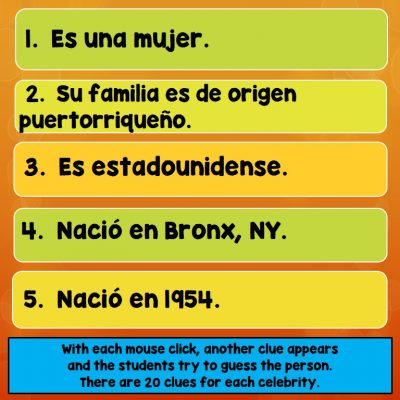
Famous Hispanics Game, Lesson Plans
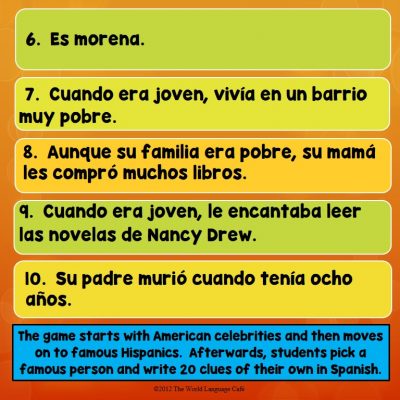
Famous Hispanics Game, Lesson Plans
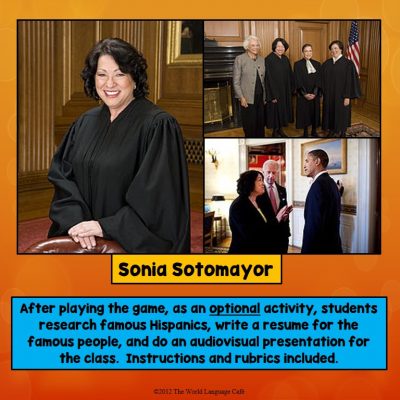
Famous Hispanics Game, Lesson Plans
17. Incorporate a Music Project
Students divide into small groups and pick their favorite song in the target language and then learn all the words and either perform in front of the class or make a video for class. Read more details about how to do this or how to host a World Language Lip Sync Night.

Host a World Language Lip Sync Night
OR select a few songs in the target language for the students to transcribe and teach to the class. Try to pick songs that are easier to understand, not too fast, and that have some deeper meaning/culture to them.
Divide the class into groups of 2-3 and give each group a song to work on. Their assignment is to listen to the song and write down the words. Then they select 5 vocabulary words from the song to teach to the class in the target language and come up with a gesture for each word so that when the class hears the keywords, they do the gestures. They prepare a presentation explaining some biographical information about the singer/band, 5 questions to ask the class, and an explanation of the meaning/significance of the song.
Hope these French and Spanish end of year activities make your life easier and keep your students engaged and learning these last few months.

16 French, Spanish End of Year Review Activities, Games
Remember to get your Free World Language Games by signing up below.



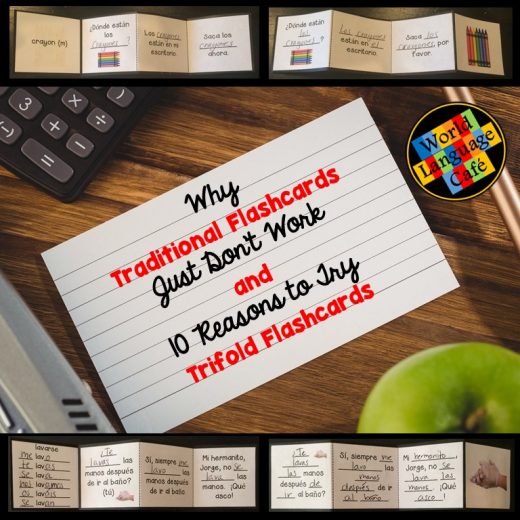

1 Comment
Laura McClintock
June 25, 2018 at 7:00 pmExcellent post! I definitely plan on stealing a lot of these ideas! I love the idea of having students write a letter to next year’s class. That is such a practical and engaging task for students. I also love the fairy tale idea! I can definitely see myself using many of these ideas. I know the year is already over, but I figured it’s never too late to share my recent post for strategies for surviving the end of the year: http://teachinginthetargetlanguage.com/surviving-those-last-days-of-school-lets-keep-our-world-language-students-motivated/. Maybe you will find some of these useful. Thank you for sharing these ideas. I am looking forward to putting these to use next year! In the meantime, enjoy your summer! 🙂